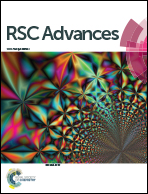Proline-functionalized chitosan–palladium(ii) complex, a novel nanocatalyst for C–C bond formation in water†
Abstract
An environmentally friendly palladium-based catalyst supported on proline-functionalized chitosan was successfully prepared and evaluated as a heterogeneous nanocatalyst in the Suzuki cross-coupling reaction of various aryl halides with phenylboronic acid. The catalyst was characterized by FT-IR, FE-SEM, TEM, XRD, SEM-EDX, ICP and TGA techniques and exhibited reasonable catalytic activity in the reaction system, producing substituted biaryls in good to excellent yields. In addition, the catalyst could be recovered in a facile manner from the reaction mixture and recycled several times.


 Please wait while we load your content...
Please wait while we load your content...